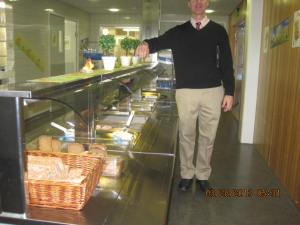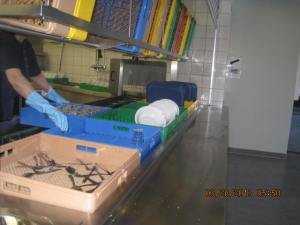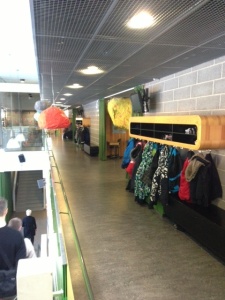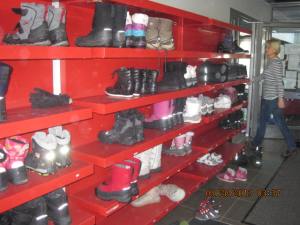The Baltic Sea winter climate of Helsinki necessitates hats, mittens, gloves and warm coats, every day — even at the end of March. At breakfast my first morning, I noticed the coat racks. In Vermont, on a cold, raw, snowy or rainy day, we do one of several things with outer clothing. The first is we stuff them into cubbies. If they are wet, they stay a little clammy all day. Alternately, we might stuff the mittens and hat into the sleeve of the coat, so they are not lost or forgotten, then we hang our coat. As a third option we might put mittens or hats on a heater that is slanted (not made to dry clothes) in the hopes of achieving dryness, but they slide off or need repositioning.
Check out a coat rack from the cafeteria at the University of Helsinki dormitory. Notice the efficient, practical, aesthetically pleasing places to securely rest mittens, gloves and coats so they dry.
During my visit to three schools in Finland I noticed use of building space, educational teaching devices, storage and schooling that exuded a message of practical, efficient and aesthetic. Even the University classroom had a coat rack provided for boots, coats, hats and gloves. The inanimate physical attributes provide an ability for the people in these schools to focus on learning — without the subliminal frustrations from impracticalities that dare I say might distract our ability to focus on education.
In school lunchrooms I visited, there were sinks, efficiently placed first in the lunch line in the cafeteria. The Finnish children washed their hands before they ate. Message: we support health and cleanliness, right here, front and center in the cafeteria.
In the lunch lines, children served themselves, the food line was at little person level, just the right height for a child. Are our lunch lines miniature and child focused?
 When done with the food and trays, the children put away their plates, compost, trash, and silverware into the racks and receptacles, making clean up efficient and easy. Do your children take responsibility for cleanup and help the cafeteria staff by sorting?
When done with the food and trays, the children put away their plates, compost, trash, and silverware into the racks and receptacles, making clean up efficient and easy. Do your children take responsibility for cleanup and help the cafeteria staff by sorting?
The lunch rooms were decorated with cloth table runners, bright colors, art, and centerpieces on each table. Many of the tables had bright grass sprouts in a bowl. Are our cafeterias pleasing to the eye, relaxing and soothing the inner child.
Take a look at your school cafeterias, lunch lines, clean up areas and procedures in your school. Are they institutional? Do they promote self sufficiency, aesthetic pleasure, responsibility, trust and independence?
 What do you do with the coats and shoes of your young scholars? Are they stuffed in cubbies in rooms, or is the learning space reserved for learning and the coat efficiently drying outside the room?
What do you do with the coats and shoes of your young scholars? Are they stuffed in cubbies in rooms, or is the learning space reserved for learning and the coat efficiently drying outside the room?
In one elementary school, the children removed their shoes as they entered the school. They learn in their stocking feet and the teacher had on a pair of hand knit, felted wool deep purple socks.
Even the classrooms had practical features. The erasers for the chalkboards were on long handles, so erasure of information was instantaneous, clean and practical.
Perhaps learning is not the little classroom efficiencies, coat racks or the way that children are expected to put away their dishes. However, from these three schools I observed respect for children to make their own decisions, enjoy their meal time and focus on learning.
As I finish my post, I just used the restroom and noticed the shower drain. I noticed a perfectly fitted, removable, three tiered slime catchment designed to easily prevent clogs. Why waste time unclogging all of the University housing showers when you can design a catchment device that works?
You can then focus on learning! Notice the giant squeegee to efficiently schlop all the spilled water on the shower floor.
As I write these last few words, my daughter opened the fridge (in the common area) to remove food. It started beeping after 10 seconds. Translation: you are wasting electricity, shut the door!
At the end of the day, critically look at the spaces in your school, the cubbies, the storage, the eating areas, the clean up places. Create practical, efficient infrastructural details so we can focus on education and learning — by saving time, and pleasing our aesthetic soul so youth will not feel subconscious distractions that drain emotional energy. If our children have toasty warm fingers versus clammy hands on their way home, they might reflect on the successes of the day and plan for the future! It’s the coat racks! They are the reason for the success of the Finnish schools!









Well-made, attractive spaces say to children, “You are worthy of this. You are valued here.” Thank you for sharing these images and observations.
Thank you so much, this is much like the space you create in your library at Richmond Elementary School. I wonder if there are ways to make our cafeterias more cozy?
Great post Jen. For me it is purpose. Everything here has a purpose. People talk with a purpose-Think with a purpose-Teach with a purpose. There isn’t wasted time, space nor energy. It will be interesting to see how much more I notice these things once back on American soil. I think we can be very wasteful in personally and professionally as part of our own culture.
The well designed respectful spaces informed the ways that students interacted with their physical environment. Schools, regardless of age were neat, clean, visually appealing. But most compelling was watching 15 upper secondary students, without being told, return desks to their original location after a 90-minute calculus class. Wow!